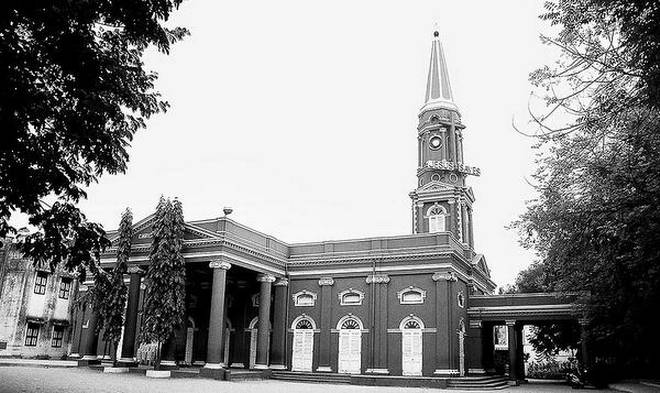The East Indians, as Anglo Indians were known till 1911, were well served by schools and churches in almost every locality where they were in numbers. In New Town and Vepery areas, near where they served in the General Hospital and Gun Factory, the German missionaries representing the Society for Promoting Christian Knowledge had done their bit. In Royapuram, the railway and harbour employees were well served by St Kevin’s and St Peter’s. And in Perambur, the railway hub, there was the Railways School and the Lourdes Shrine, all serving Protestants and Catholics. But where the poorest East Indians lived, in the Narasingapuram, Chintadripet, Pudupet and Royapettah areas there was nothing between St Mary’s in the Fort and St George’s Cathedral for those who worked in stables like Waller’s, coach-builders like Simpson’s, as printers in Addison’s, and sales-clerks in Spencer’s and Higginbotham’s. That was till the Rev Henry Taylor arrived in 1842 and was temporarily posted to sahibdom’s St George’s.
Struck by the poorer East Indians’ conditions in the Round Tana area, Taylor rented a room there in July 1842 and commenced worship and primary classes. That will on November 26, be celebrated as the 175th anniversary of Christ Church, Mount Road, and its school. Growth followed thanks to Thomas Parker Waller who owned a large stable and coach rental here. When a building and compound he offered the new institution was deemed too small, he negotiated exchange of a part of his estate for an adjacent property and gifted in perpetuity the latter, then worth ₹ 12,000, to the new church. Here, Taylor’s successor, Rev Robert Carver (Miscellany, February 6) established in 1843 two schools called the Mount Road Male and Female Schools, to be duly called the Christ Church School. Another building in this property was used for worship. Work on the church began in 1850 to John Law’s design and Christ Church, Mount Road, was consecrated in 1852. The Church, including furniture from Deschamps, then a leading furniture maker, cost ₹ 37,000.
Remembered in the Church with a memorial tablet and in the name of a primary school opened in 1986 is TP Waller. Another tablet, one in the porch, remembers his son, a veterinarian, who died in 1830. Connected or not, another Waller name figures in the School’s history; Bishop Edward Waller (1922-41) helped the school considerably with Diocesan funding.
Funds were till the 20th Century a constant problem for the School. Typically, an 1854 note showed expenses being ₹90 a month and school fees only about ₹30 from around 120 students! It was a poor school with poorer children. This lack of funds was to over the years affect the character of the school, which kept shuttling between being a middle school and a lower school.
The history of this period is too depressing, not to mention full of upheavals, to record. But what seemed like a closed chapter became a new chapter with Waller’s infusion of funds and support from St George’s Cathedral, St Mary’s in the Fort and St Matthias, Vepery.
This made possible a new block in 1928 at a cost of ₹40,000 and recognition as a High School in 1947. In 1949, when St George’s Cathedral School closed, Christ Church welcomed its students, as numbers meant viability. Today, with over 2,000 students it is a co-educational higher secondary school from 1905 with good results and many a university entrant, a far cry from 1930 when it reported “After years of barren results, it is refreshing to find one passing in the Middle School examination”! That was a School that changed from 1936 after the previous 25 years had recorded “hardly one per cent in passes”. Since then it has been recording 90-100 % passes and students joining India’s most prestigious services and institutions. Among them is Dr John Varghese, principal of St Stephen’s College, Delhi.
The mystery of the missing award
My mention on August 27th of the Jagirdar of Arni’s Gold Medal for Physics/ Chemistry not having been awarded for years, has brought intriguing information. In letters to the Arni family in 2005, Presidency College categorically stated their records showed no such awards. Yet, in 1992, plaques were seen in the College’s Central Hall listing Arni Award winners in Physics and Chemistry.
Still more intriguing is that the CVs of many leading Indian scientists mention them as having received the award. These include Dr CV Raman in 1905, Dr Govind Rao (‘Father of Chemical Engineering in India’) in 1921, and Dr S Chandrasekhar in 1930. Later winners found include in 1956 (Physics) Dr TR Viswanathan, a Director of Texas Instruments after stints at MIT, Carnegie Mellon, Stanford and Berkeley, in 1974 (Chemistry) Dr N Pattabhiraman, Professor of Oncology, Lombardi Cancer Centre, Washington DC, Dr N Gopalaswamy (1977, Physics) who was with NASA, and Dr S Moorthy Babu, Anna University.
With so many winners, listed as late as 1986 (Dr Babu), how could an award vanish into thin air? Be that as it may, would the College like to start all over again with the help of the Arni family?
The chronicler of Madras that is Chennai tells stories of people, places, and events from the years gone by, and sometimes from today
source: http://www.thehindu.com / The Hindu / Home> Society> History & Culture> Madras Miscellany / by S Muthiah / November 07th, 2017
